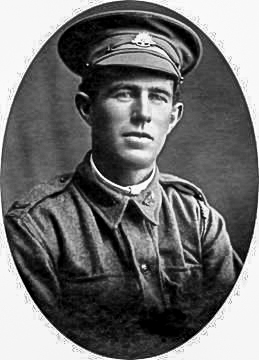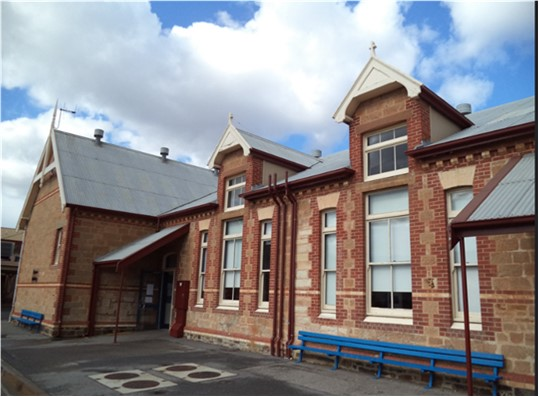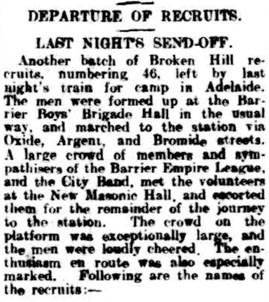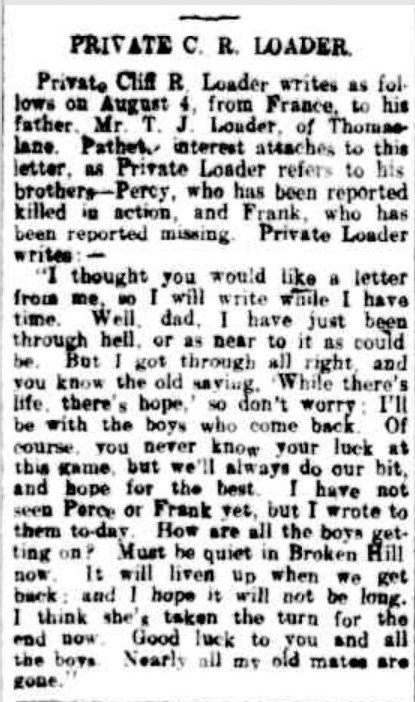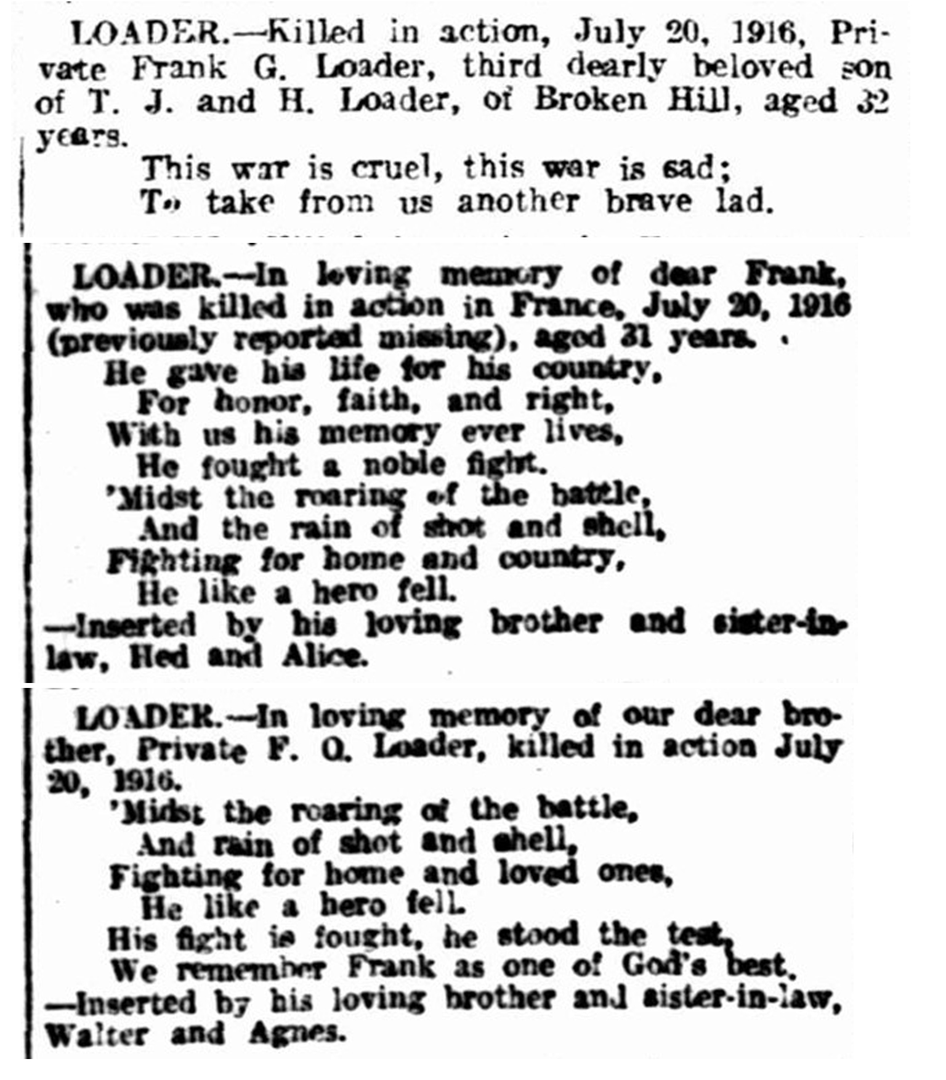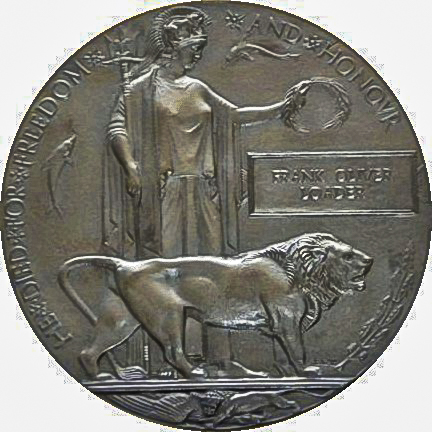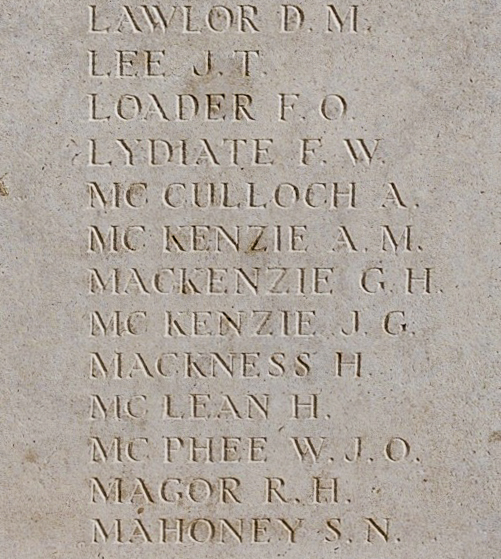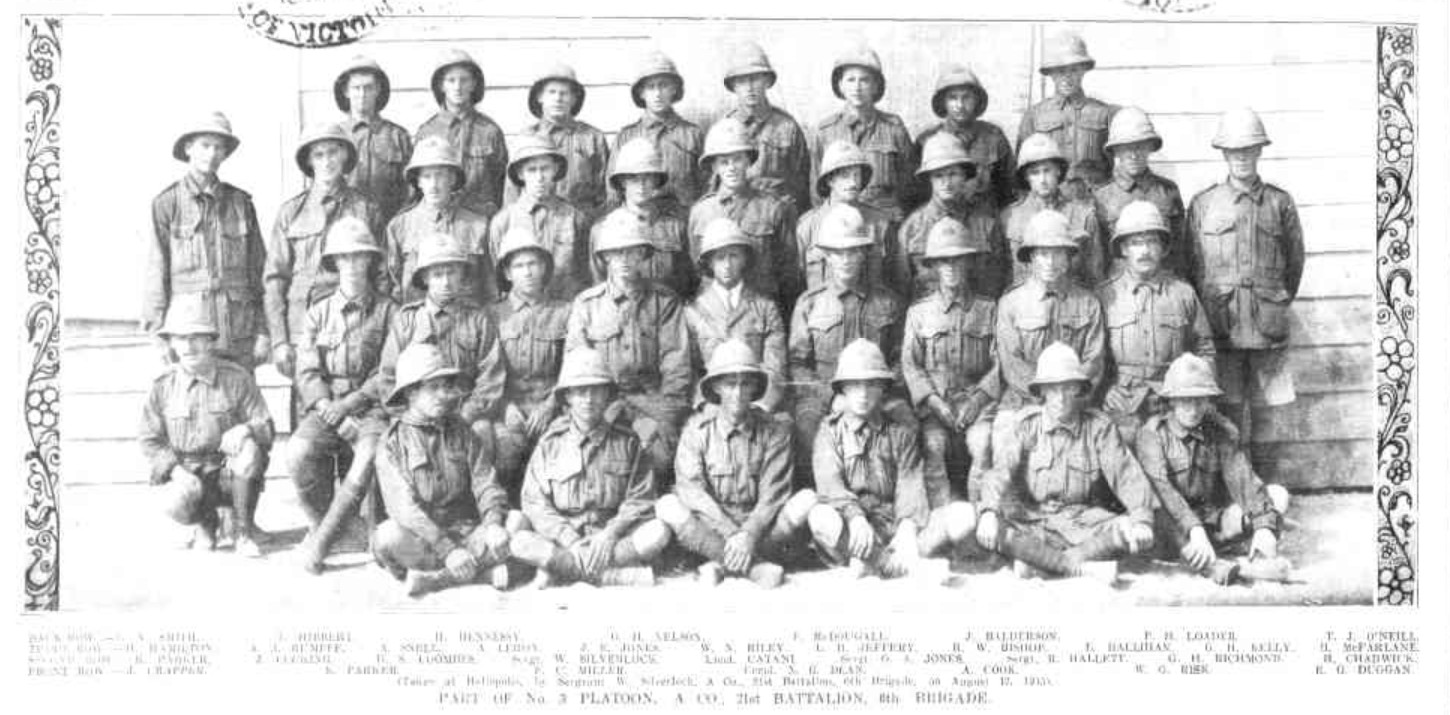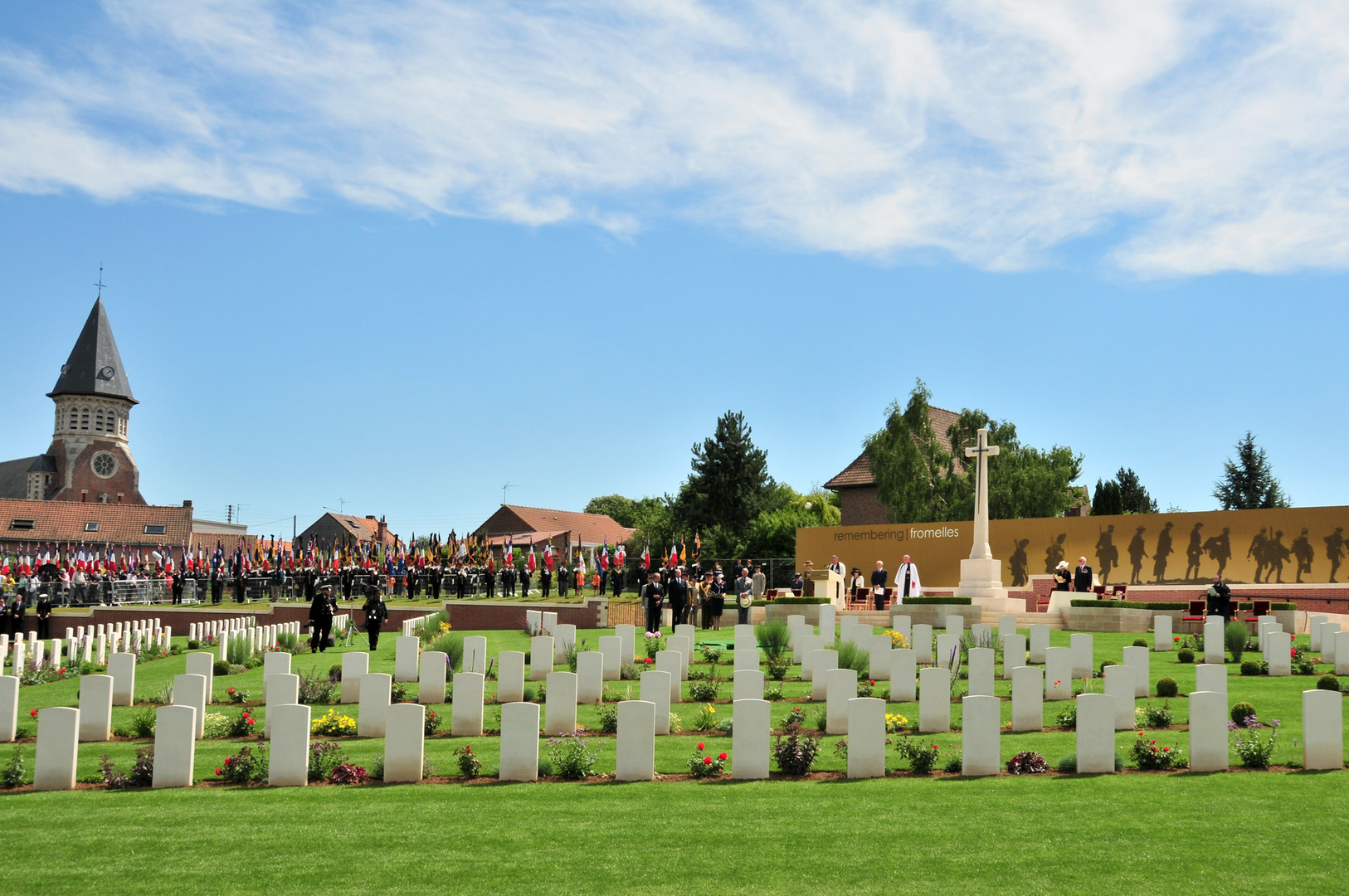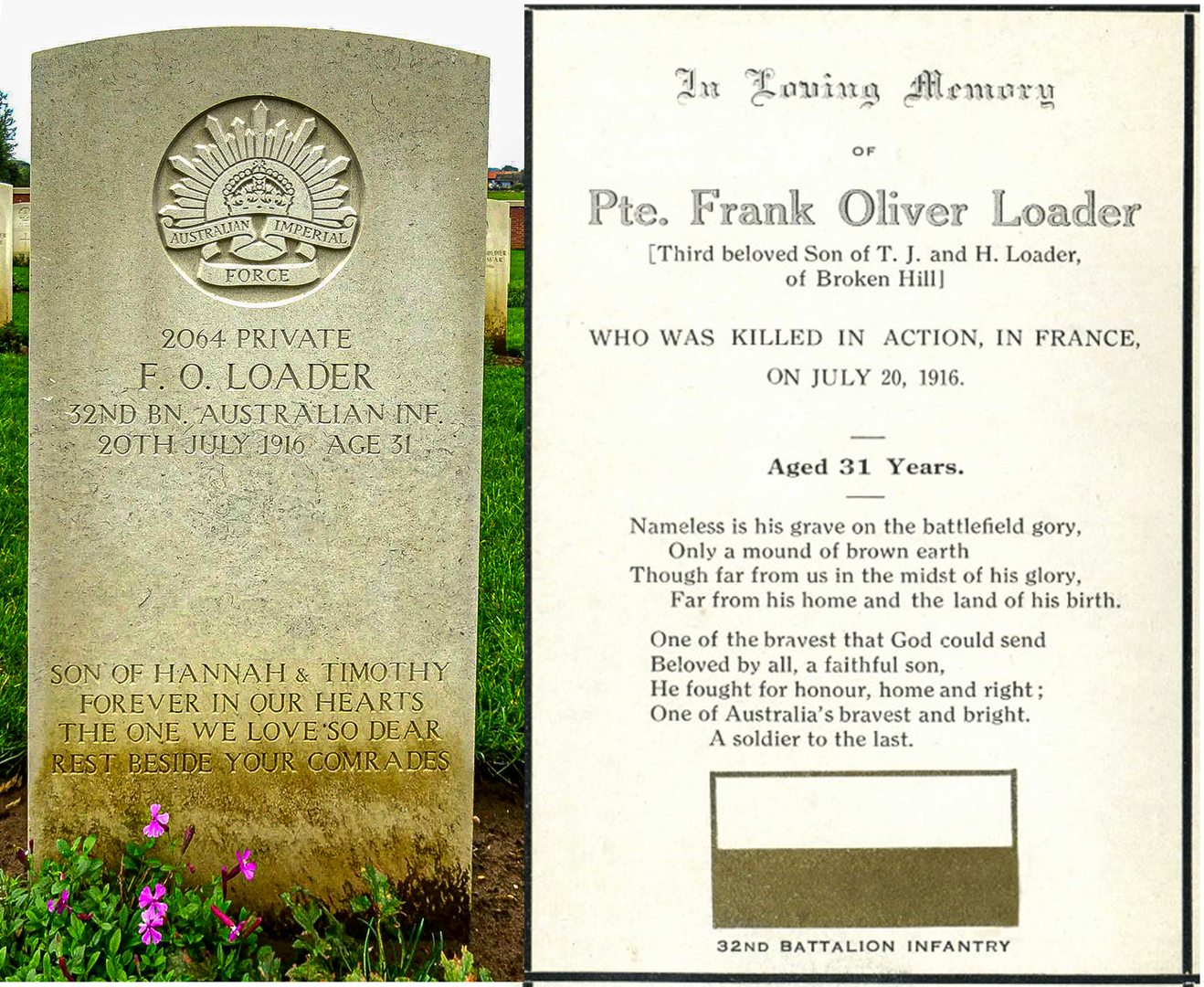Frank Oliver LOADER
Eyes blue, Hair brown, Complexion fair
The Loader Family - Three Sons Went to War, Only One Came Home
Early Life
Frank Oliver Loader, the third of Timothy Jacob and Hannah (nee Gale) Loader’s six children, five sons and one daughter, was born on 25th March 1885 in Payneham, South Australia. They lived at 20 Morris Street. The Loader family were well known in Payneham, an inner northeastern suburb of Adelaide.
Frank's grandfather Jacob Loader was one of the early colonials in the area who petitioned for the establishment of the Payneham District Council and he also served as a Councillor. His father was a carpenter. The children attended the nearby East Adelaide School.
At some stage, the family moved to Broken Hill, New South Wales, as all three sons’ enlistment records show Thomas Lane, Broken Hill as their parent’s address. Frank worked as a book maker’s clerk, Percy was a saddle maker and Clifford was a carpenter’s labourer.
Off to War
All three boys enlisted. Clifford, the youngest, was the first to enlist, December 1914 (No. 1375) and served in the 1st Pioneer battalion. He did need his parent’s endorsement to sign up, which was willingly given. Percy signed up soon after Clifford, January 1915 (No. 4421) and was a sapper in the 8th Field Company engineers.
He also served in Gallipoli from September to December and then was sent to the Somme. Frank was the last to enlist, signing up on 10 September 1915. He was assigned to the 3rd Reinforcements, 32nd Battalion. He and his mates were cheered on by the folks of Broken Hill as they headed off to begin their training in Adelaide.
The 32nd Battalion was formed at Mitcham, South Australia on 9 August 1915. A and B Companies were to be from South Australia while C and D from Western Australia. There was much fanfare about this in South Australia, with gatherings, community support, such as the Cheer-up Society and reviews of the troops by the Premier.
The men from WA arrived in Adelaide at the end of September and training for all continued there until they departed for Egypt on 18 November 1915 on the troop ship HMAT A2 Geelong.
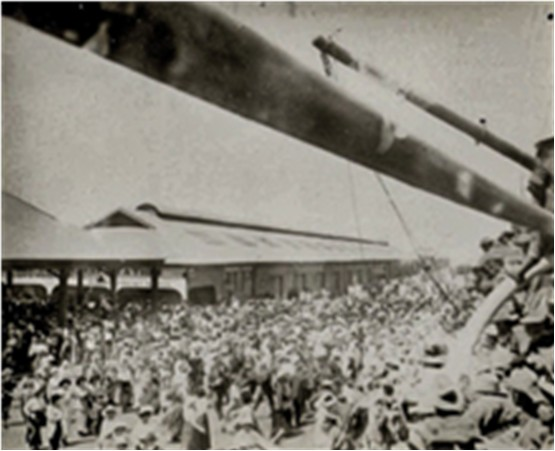
As reported in The Adelaide Register:
“The 32nd Battalion went away with the determination to uphold the newborn prestige of Australian troops, and they were accorded a farewell which reflected the assurance of South Australians that that resolve would be realized.”
Egypt
The 32nd arrived in Suez on 14 December 1915 and moved to El Ferdan just before Christmas. A month later they marched to Ismailia, then to Tel el Kebir for February and most of March. The next stop was at Duntroon Plateau and Ferry Post until the end of May, training and guarding the Suez Canal. Their last posting in Egypt was a few weeks at Moascar.
One soldier’s diary complained of being “sick up to the neck of heat and flies”, of the scarcity of water during their long marches through the sand and he described some of the food as “dog biscuits and bully beef”. He did go on to mention good times as well with swims, mail from home, visiting the local sights and the like.
Source: AWM C2081789 Diary of Theodor Milton PFLAUM 1915-16, page 29, page 12
During their time in Egypt the 32nd had the honour of being inspected by H.R.H. Prince of Wales.
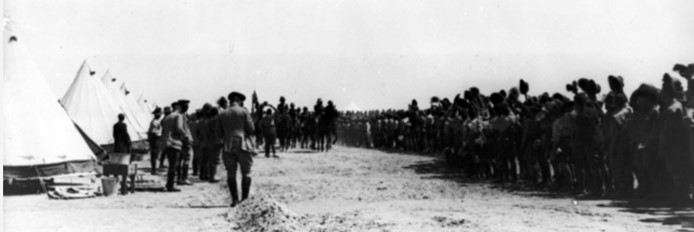
To the Western Front
After spending six months in Egypt, the call to support the British Expeditionary Force on the Western Front came in mid-June. They left from Alexandria on the ship Transylvania on 17 June 1916 and arrived at Marseilles, France on 23 June 1916. They then had a two-day train trip to Steenbecque.
Their route took them to a station just out of Paris, within sight of the Eiffel Tower, through Bologne and Calais, with a view of the Channel, before they disembarked and marched to their camp at Morbecque, about 30 kilometres from Fleurbaix.
Theodor Pflaum (No. 327) wrote about the trip in his diary:
“The people flocked out all along the line and cheered us as though we had the Kaiser as prisoner on board!!”
Wesley Choat (No. 68), for one, was glad to be out of Egypt, but he was well aware of what laid ahead:
“The change of scenery in La Belle France was like healing ointment to our sunbaked faces and dust filled eyes. It seemed a veritable paradise, and it was hard to realise that in this land of seeming peace and picturesque beauty, one of the most fearful wars of all time was raging in the ruthless and devastating manner of "Hun" frightfulness”.
Training continued with a focus on bayonets and the use of gas masks, assuredly with a greater emphasis given their position near the front.
Fromelles
The 32nd moved to the front on 14 July and were into the trenches for the first time on 16 July, only three weeks after arriving in France. On the 17th they were reconnoitring the trenches and cutting passages through the wires, preparing for an attack, but it was delayed due to the weather. D Company’s Lieutenant Sam Mills’ letters home were optimistic for the coming battle:
“We are not doing much work now, just enough to keep us fit—mostly route marching and helmet drill. We have our gas helmets and steel helmets, so we are prepared for anything. They are both very good, so a man is pretty safe.”
The overall plan was to use Brigades from the Australian Fifth Division to conduct a diversionary assault of the German trenches at Fromelles. The 32nd Battalion’s position was on the left flank, with only 100 metres of no man’s land to get the German trenches. As they advanced they were to link up with the 31st Battalion on their right.
However, their position on the extreme left flank made their job more difficult, as not only did they have to protect themselves while advancing, but they also had to block off the Germans on their left, to stop them from coming around behind them. On the morning of the 18th, A and C Companies went back into the trenches to relieve B and D Companies.
B and D rejoined on the 19th. All were in position by 5.45 PM and they went over the parapet at 5.53 PM. Frank’s A Company and C Company were the first and second waves to go, B and D the third and fourth. They were successful in the initial assaults and by 6.30 PM were in control of the German’s 1st line system, which was described as:
“practically a ditch with from 1 to 2 feet of mud and slush at the bottom”.
Unfortunately, with the success of their attack, ‘friendly’ artillery fire caused a large number of casualties. They were able to take out a German machine gun in their early advances, but were being “seriously enfiladed” from their left flank. By 8.30 PM their left flank had come under heavy bombardment with high explosives and shrapnel.
Return bombardment support was provided and the 32nd was told that “the trenches were to be held at all costs”.
Source: AWM4 23/49/12, 32nd Battalion War Diaries, July 1916, page 12
Fighting continued through the night. The Australians made a further charge at the main German line, but they were low on grenades, there was machine gun fire from behind them from the emplacement at Delangre Farm and they were so far advanced that they were getting shelled by both sides.
At 4.00 AM the Germans began an attack from the Australian’s left flank. Given the Australian advances that had been made earlier, their rear trench had been left almost empty, which enabled the Germans to be in a position to surround the soldiers of the 32nd.
At 5.30 AM the Germans attacked from both flanks in force and with bombing parties. Having only a few grenades left, the only resistance that could be offered was with rifles:
“The enemy swarmed in and the retirement across No Mans’ Land resembled shambles, the enemy artillery and machine guns doing deadly damage.”
What was left of the 32nd had finally withdrawn by 7.30 AM on the 20th. The initial roll call count was devastating – 71 killed, 375 wounded and 219 missing. To get some perspective of the battle, when Charles Bean, Australia’s official war historian, attended the battlefield two and half years later, he observed a large amount of bones, torn uniforms and Australian kit still on the battlefield.
The final impact was that 228 soldiers of the 32nd Battalion were killed or died from wounds sustained at the battle and, of this, 166 were unidentified.
Lieutenant Sam Mills survived the battle. In his letters home, he recalls the bravery of the men:
“They came over the parapet like racehorses……… However, a man could ask nothing better, if he had to go, than to go in a charge like that, and they certainly did their job like heroes."
Two Sons Lost in Two Months
Frank was among those who were missing at roll call. His family was advised of this, but there no further details were able to be provided. A month later, with still no news on Frank, they received the news that Percy had been killed at Poziers/Moquet Farm on 20 August. Two sons lost in two months.
Frank and Percy's younger brother Cliff had written home on 4 August, but he did not know that Frank had been killed – “I have not seen Perce or Frank, but I wrote to them to-day. How are the boys getting on?” He must have been devasted when he learned that he had lost BOTH brothers.
By early 1917 the Army had not provided any further news about Frank. They were typically cautious, checking for POW/hospitals/etc, and with the thousands of soldiers to look after it was a challenge. Frank’s father, Timothy, had contacted a fellow soldier from Broken Hill, Martin Murphy, to see if he was able to find out anything about Frank.
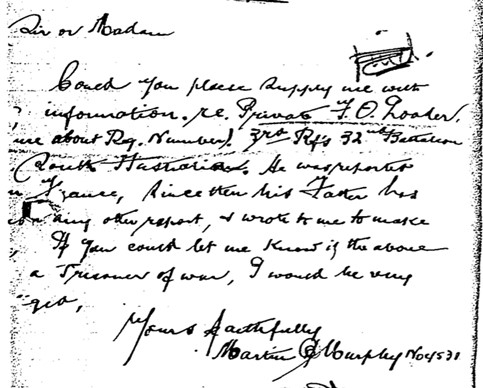
Not long before this exchange, the Army had received reports from the Germans that Frank’s body had been recovered by the Germans.

While this states a “Prisoner of War”, it also states “Dead”, meaning that the Germans had recovered Frank’s body and ID tags, which were returned.In late February, Frank was officially declared as having been Killed in Action. He was clearly missed. There were a number of heartfelt tributes to Frank from his family in the newspapers (several are below).
The Army did provide photographs of Percy’s grave, so the family could have some closure, but Frank remained “missing”. Frank was awarded the Victory Medal, the British War Medal and a Memorial Plaque and a Memorial Scroll.
He is commemorated at:
- VC Corner, Fromelles France, Panel 5,
- the Adelaide National War Memorial,
- the Broken Hill Barrier District Roll of Honour,
- the Broken Hill War Memorial,
- the Payneham Roll of Honour
- and the St Peters Heroes of the Great War Honour Roll.
Brothers
Frank’s youngest brother Clifford was in the 1st Pioneer Battalion. He served in Gallipoli from September to December 1915 and later in France. He survived the war and returned to Australia. Percy was originally with the 21st Battalion, before becoming a sapper with 8th Field Company Engineers. He also served in Gallipoli from September to December 1915.
After time in Egypt (we don’t know if the brothers were able to meet while there), he was sent to France at the end of June 1916 and fought in the battle at Pozieres / Mouquet Farm.
He did not take part in the Battle of Fromelles as he was in hospital at the time. Unfortunately, he received gunshot wounds to his chest, leg and arm died at the casualty clearing station on 20 August 1916, a month after Frank had been killed. His final burial place is the Estaires Communal Cemetery and Extension, Lot II Row H Grave number 10. The Army did provide the family with photos of Percy’s grave, so some closure was possible. Not so for Frank.
Finding Frank
With the German Death List, we know that Frank’s body was found on the battlefield, but there were no records of his burial. However, 92 years later, a mass grave which contained 250 Australian soldiers was discovered near the area in which Frank had been fighting. A major effort was undertaken to seek to Identify the soldiers in the grave by DNA matching from family members.
Frank was one of the first 96 soldiers to be identified and he was laid to rest in the Fromelles (Pheasant Wood) Military Cemetery on 20 July 2010 in Plot 1, row c, and grave number 9.
Prince Charles, the Governor General of Australia Quentin Bryce and other top officials and families of some of the soldiers were to attend the ceremony. A group of Adelaide students with the group ‘Connecting Spirits’ had also been researching the soldiers and attended the cemetery in December. Amanda Hartley writes:
After two years researching Frank Oliver Loader I finally reached his resting place at this new Fromelles cemetery. Covered in snow, visibility in the area was reduced by a thick fog and it was hard to imagine that in July they had a heat wave here.
We were there to do a job and pay respect to our fallen. I told a story about Frank and assured him I would return home telling the family where he is and describe his surroundings. I laid photos of his parents’ gravesite and a group photo of the 12 family members who we used for DNA samples plus numerous other bits and pieces.
I stood up paying respects when the church bell chimed twice for 2 o’clock. I nearly fell over.
The mayor of Fromelles welcomed us and presented us with a commemorative postcard of Fromelles. Just so special! In icy conditions. Tears came easily as it was time to leave but I wasn’t the only one. We were off to our next commemoration which happened to be Frank’s brother Percival.
The identification effort is still underway and as of 2024, 180 of the 250 soldiers in the grave have been identified.
FOREVER IN OUR HEARTS
THE ONE WE LOVE SO DEAR
REST BESIDE YOUR COMRADES
The Fromelles Association would love to hear from you

Contacts
(Contact: carla@fromelles.info or geoffrey@fromelles.info).
(Contact: army.uwc@defence.gov.au or phone 1800 019 090).
Donations
If you are able, please contribute to the upkeep of this resource.
(Contact: bill@fromelles.info ).
